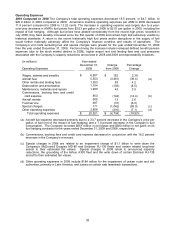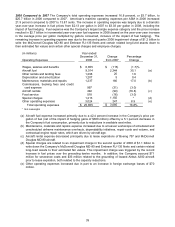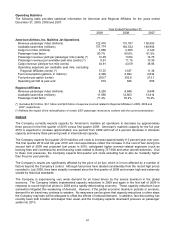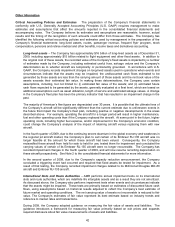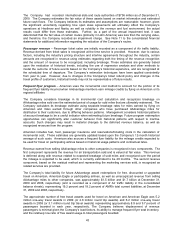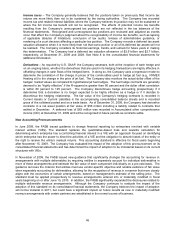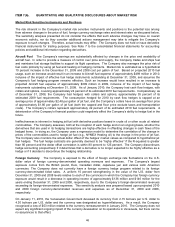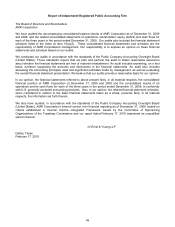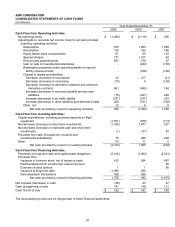American Airlines 2009 Annual Report Download - page 48
Download and view the complete annual report
Please find page 48 of the 2009 American Airlines annual report below. You can navigate through the pages in the report by either clicking on the pages listed below, or by using the keyword search tool below to find specific information within the annual report.45
Income taxes – The Company generally believes that the positions taken on previously filed income tax
returns are more likely than not to be sustained by the taxing authorities. The Company has recorded
income tax and related interest liabilities where the Company believes its position may not be sustained or
where the full income tax benefit will not be recognized. The effects of potential income tax benefits
resulting from the Company’s unrecognized tax positions are not reflected in the tax balances of the
financial statements. Recognized and unrecognized tax positions are reviewed and adjusted as events
occur that affect the Company’s judgment about the recognizability of income tax benefits, such as lapsing
of applicable statutes of limitations, conclusion of tax audits, release of administrative guidance, or
rendering of a court decision affecting a particular tax position. The Company records a deferred tax asset
valuation allowance when it is more likely than not that some portion or all of its deferred tax assets will not
be realized. The Company considers its historical earnings, trends, and outlook for future years in making
this determination. The Company had a deferred tax valuation allowance of $2.9 billion and $2.7 billion,
respectively, at December 31, 2009 and 2008. See Note 8 to the consolidated financial statements for
additional information.
Derivatives – As required by U.S. GAAP, the Company assesses, both at the inception of each hedge and
on an ongoing basis, whether the derivatives that are used in its hedging transactions are highly effective in
offsetting changes in cash flows of the hedged items. In doing so, the Company uses a regression model to
determine the correlation of the change in prices of the commodities used to hedge jet fuel (e.g., NYMEX
Heating oil) to the change in the price of jet fuel. The Company also monitors the actual dollar offset of the
hedges’ market values as compared to hypothetical jet fuel hedges. The fuel hedge contracts are generally
deemed to be ―highly effective‖ if the R-squared is greater than 80 percent and the dollar offset correlation
is within 80 percent to 125 percent. The Company discontinues hedge accounting prospectively if it
determines that a derivative is no longer expected to be highly effective as a hedge or if it decides to
discontinue the hedging relationship. The fair value of the Company’s hedging contracts is recorded in
Current Assets or Current Liabilities in the accompanying consolidated balance sheets and is recorded
gross of the collateral posted and on a trade basis. As of December 31, 2009, the Company had derivative
contracts in a net asset position at fair value of $55 million including a liability related to contracts that
settled in December. A deferred loss of $63 million was recorded in Accumulated other comprehensive
income (OCI) at December 31, 2009 and will be recognized in future periods as contracts settle.
New Accounting Pronouncements
In June 2009, the FASB issued guidance to change financial reporting by enterprises involved with variable
interest entities (VIEs). The standard replaces the quantitative-based risks and rewards calculation for
determining which enterprise has a controlling financial interest in a VIE with an approach focused on identifying
which enterprise has the power to direct the activities of a VIE and the obligation to absorb losses of the entity or
the right to receive the entity’s residual returns. This accounting standard is effective for fiscal years beginning
after November 15, 2009. The Company has evaluated the impact of the adoption of this pronouncement on its
consolidated financial statements and has determined the impact of adoption to be immaterial based on its current
structures with VIEs.
In November of 2009, the FASB issued new guidance that significantly changes the accounting for revenue in
arrangements with multiple deliverables by requiring entities to separately account for individual deliverables in
more of these arrangements and estimate the fair value of each component individually on a pro-rata basis. The
guidance removes the criterion that entities must use vendor-specific objective and reliable evidence of fair value
when separately accounting for deliverables, allowing for the recognition of revenue in a manner that more closely
aligns with the economics of certain arrangements, based on management’s estimate of the selling price. The
standard must be applied prospectively to revenue arrangements entered into or materially modified in fiscal
years beginning on or after June 15, 2010. In addition, the FASB significantly expanded the disclosures related to
multiple deliverable revenue arrangements. Although the Company continues to evaluate the impact of the
adoption of this standard on its consolidated financial statements, the Company believes the impact of adoption
will not be material in 2011, but could have a significant impact on future results as new or materially modified
revenue arrangements with certain partners are established in the normal course of business.





